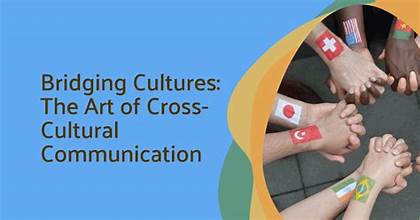In today’s increasingly interconnected world, effective cross-cultural communication is more crucial than ever. As globalization continues to blur geographical and cultural boundaries, individuals and organizations must navigate a complex web of cultural differences to foster meaningful interactions and collaborations. In 2024, mastering the art of cross-cultural communication can lead to improved relationships, enhanced business success, and greater personal growth. This article explores essential strategies for effective cross-cultural communication in the contemporary landscape.
1. Understanding Cultural Contexts
The foundation of effective cross-cultural communication lies in understanding the cultural contexts of the people you are interacting with. Cultures shape how people perceive, interpret, and respond to communication. Key elements include:
- Communication Styles: Cultures vary in their approach to communication. Some cultures, such as those in East Asia, may prefer indirect communication to avoid confrontation, while others, like those in the United States, may favor directness and clarity.
- Non-Verbal Cues: Body language, eye contact, and gestures can differ significantly across cultures. For example, while maintaining eye contact is seen as a sign of confidence in many Western cultures, it may be considered disrespectful in certain Asian cultures.
- Values and Beliefs: Cultural values influence priorities and decision-making processes. Understanding whether a culture values individualism or collectivism, for instance, can help you navigate conversations and negotiations more effectively.
2. Developing Cultural Intelligence
Cultural intelligence (CQ) is the ability to relate to and work effectively across cultures. Enhancing your CQ involves:
- Knowledge: Learn about the cultures you are interacting with. This includes understanding historical backgrounds, social norms, and common practices.
- Sensitivity: Cultivate an awareness of how your own cultural background affects your communication. Recognize that your perspective is not universal and be open to different ways of thinking and behaving.
- Adaptability: Be flexible in your communication style. Adapt your approach based on the cultural context and be willing to adjust your methods as needed.
- Empathy: Put yourself in the other person’s shoes. Empathy helps bridge gaps in understanding and can build stronger connections.
3. Active Listening and Open-Ended Questions
Effective cross-cultural communication requires active listening and the use of open-ended questions to encourage dialogue and ensure clarity:
- Active Listening: Focus on what the other person is saying without interrupting. Show that you are engaged by nodding, maintaining eye contact, and summarizing their points to confirm understanding.
- Open-Ended Questions: Use questions that require more than a yes or no answer to explore deeper insights. For example, instead of asking “Do you like this?” you might ask, “What are your thoughts on this topic?”
- Clarification: When in doubt, seek clarification to avoid misunderstandings. Phrasing questions like, “Could you explain that further?” can help ensure that both parties are on the same page.
4. Building Relationships and Trust
Trust is a cornerstone of effective communication. To build and maintain trust in cross-cultural interactions:
- Consistency: Be reliable and consistent in your actions and communications. Follow through on commitments and be transparent in your intentions.
- Respect: Show respect for cultural norms and practices. This might involve adjusting your behavior to align with local customs or acknowledging cultural holidays and traditions.
- Personal Connections: Invest time in building personal relationships. Understanding people’s backgrounds and sharing your own experiences can foster mutual respect and trust.
5. Overcoming Language Barriers
Language differences can pose significant challenges in cross-cultural communication. To navigate these barriers:
- Use Simple Language: Avoid jargon and complex phrases that may not translate well. Use clear, simple language to convey your message.
- Learn Key Phrases: Learning basic phrases in the other person’s language can show respect and facilitate smoother interactions. Even simple greetings or polite expressions can make a difference.
- Utilize Technology: Leverage translation apps and tools to assist with communication. However, be mindful of potential inaccuracies and always double-check critical information.
6. Navigating Cultural Norms and Etiquette
Cultural norms and etiquette vary widely, and respecting these differences is vital for effective communication:
- Greetings: Different cultures have unique ways of greeting others. For example, a handshake may be standard in many Western cultures, while bowing is common in Japan.
- Business Practices: Be aware of different business etiquette, such as how meetings are conducted, decision-making processes, and negotiation styles.
- Social Customs: Understanding social customs, such as dining etiquette or gift-giving practices, can enhance your interactions and avoid unintentional offenses.
7. Handling Conflict and Misunderstandings
Conflict and misunderstandings are inevitable in cross-cultural interactions. To address these effectively:
- Stay Calm: Maintain composure and avoid reacting emotionally. Approach conflicts with a problem-solving mindset.
- Seek Solutions: Focus on finding mutually acceptable solutions rather than assigning blame. Engage in open and respectful discussions to resolve issues.
- Learn from Mistakes: Reflect on any missteps and learn from them. Use these experiences to improve future interactions and avoid repeating the same errors.
8. Continuous Learning and Adaptation
Cross-cultural communication is an ongoing process that requires continuous learning and adaptation:
- Stay Informed: Keep up with cultural trends and changes. This includes staying informed about global events and shifts in cultural dynamics.
- Seek Feedback: Regularly seek feedback from others about your communication style and effectiveness. Use this feedback to make improvements.
- Practice Regularly: Engage in diverse cultural interactions to practice and refine your skills. The more you immerse yourself in different cultural contexts, the more proficient you will become.
Conclusion
Effective cross-cultural communication is essential in the globalized world of 2024. By understanding cultural contexts, developing cultural intelligence, practicing active listening, building trust, overcoming language barriers, navigating cultural norms, handling conflicts, and committing to continuous learning, individuals and organizations can bridge cultural divides and foster more meaningful and productive interactions. Embracing these strategies will not only enhance personal and professional relationships but also contribute to a more inclusive and harmonious global community.


